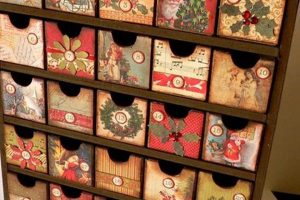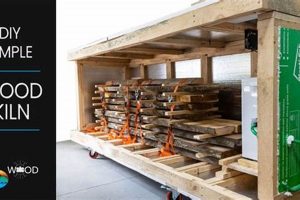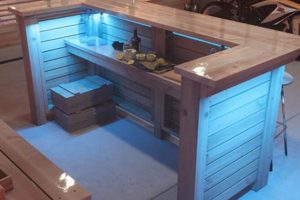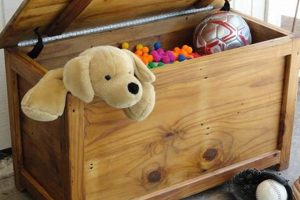The crafting of personalized gifts from timber offers a unique avenue for creative expression. These handcrafted items range from simple ornaments to complex furniture pieces, all sharing the common characteristic of being constructed primarily from wood materials and intended for presentation as gifts. A small, hand-carved wooden box, or a meticulously assembled wooden toy, exemplifies this approach.
This practice presents several advantages. It allows for a high degree of personalization, enabling the creator to tailor the gift to the recipient’s specific tastes and preferences. Furthermore, the act of creating a gift by hand adds sentimental value, conveying a level of care and consideration that mass-produced items often lack. Historically, such crafts have been a significant part of gift-giving traditions, reflecting the maker’s skill and the availability of natural resources.
The following sections will delve into specific project ideas, necessary tools and techniques, and safety considerations relevant to creating distinctive and memorable timber-based offerings. Consideration will also be given to different types of wood, finishing options, and design principles that contribute to a successful outcome.
Tips for Creating Wooden Gifts
Producing appealing and durable wooden gifts requires careful planning and execution. The following tips provide guidance for achieving successful results.
Tip 1: Select Appropriate Wood: Consider the wood’s properties. Softwoods like pine are easier to work with but less durable. Hardwoods such as oak or maple offer greater strength and a finer finish. The intended use of the gift should guide material selection. A cutting board, for instance, necessitates a hardwood.
Tip 2: Design for Skill Level: Begin with simple projects. Intricate designs require advanced woodworking skills. Starting with basic shapes and joinery techniques ensures a higher likelihood of success and reduces material waste. A simple wooden box is an ideal starting point.
Tip 3: Utilize Accurate Measurements: Precise measurements are crucial for proper assembly. Inaccurate cuts lead to misalignments and structural weakness. Employ a quality measuring tape and mark all cuts clearly before proceeding. Double-check measurements to minimize errors.
Tip 4: Prioritize Safety: Woodworking involves power tools and sharp implements. Wear appropriate safety gear, including eye protection and a dust mask. Ensure that all power tools are properly maintained and used according to manufacturer instructions. Securely clamp workpieces to prevent movement during cutting or sanding.
Tip 5: Master Sanding Techniques: Sanding is essential for achieving a smooth and professional finish. Begin with coarse-grit sandpaper to remove imperfections, then gradually transition to finer grits. Sand with the grain to avoid scratches. Thoroughly remove sawdust between each sanding pass.
Tip 6: Apply Protective Finishes: A finish protects the wood from moisture and wear, enhancing its durability. Choose a finish appropriate for the intended use. For items that will come into contact with food, select a food-safe finish. Apply multiple thin coats, allowing each coat to dry completely before applying the next.
Tip 7: Incorporate Personalization: Consider adding a personal touch. Engraving, painting, or wood burning can transform a simple wooden object into a cherished keepsake. Use stencils or freehand techniques to create unique designs.
Adherence to these recommendations enhances the quality and longevity of handcrafted wooden gifts. Thoughtful material selection, careful execution, and attention to detail are key to producing items that are both beautiful and functional.
The subsequent sections will explore specific gift ideas and offer more detailed guidance on various woodworking techniques.
1. Material Properties
The selection of appropriate materials is paramount in the successful creation of timber-based gifts. The inherent properties of various wood species directly influence the aesthetic appeal, structural integrity, and longevity of the finished product. Therefore, understanding these characteristics is essential for effective design and execution.
- Wood Hardness and Workability
The hardness of wood dictates the effort required for cutting, shaping, and fastening. Softer woods, such as pine or cedar, are easier to manipulate with hand tools, making them suitable for beginners and intricate carvings. Conversely, hardwoods like oak or maple resist dents and scratches, providing greater durability but demanding more robust tools and techniques. The chosen species should align with the complexity of the project and the available skillset.
- Grain Pattern and Aesthetic Appeal
The grain pattern of wood significantly contributes to the visual appeal of a finished item. Woods with prominent grain patterns, such as walnut or cherry, offer inherent decorative qualities. Straight-grained woods, like maple, provide a cleaner, more uniform appearance. The grain pattern should complement the design aesthetic and intended function of the gift. For example, a cutting board may benefit from a closed-grain wood to minimize liquid absorption.
- Dimensional Stability and Moisture Resistance
Wood is a hygroscopic material, meaning it absorbs and releases moisture from the surrounding environment. This can cause dimensional changes, leading to warping, cracking, or joint failure. Species with high dimensional stability, such as teak or mahogany, are less susceptible to these issues. The intended environment in which the gift will be used should inform wood selection. Items exposed to moisture require species with inherent water resistance or appropriate protective finishes.
- Wood Toxicity and Safety
Certain wood species contain natural oils or compounds that can cause allergic reactions or skin irritation. It is imperative to research the potential toxicity of a chosen species before handling it, particularly if the gift will be used in contact with food. Species like black walnut can cause allergic reactions in some individuals. Selecting non-toxic woods and wearing appropriate personal protective equipment minimizes the risk of adverse health effects.
Consideration of these material properties ensures that handcrafted timber gifts are both aesthetically pleasing and functionally sound. The thoughtful selection of wood species is a critical step in transforming raw materials into cherished and enduring possessions. Each project presents unique requirements, and the appropriate selection of material ensures quality and longevity.
2. Design Complexity
Design complexity, as it relates to handcrafted wooden gifts, represents the level of intricacy and sophistication involved in the conception and execution of a project. Greater design complexity typically requires advanced woodworking skills, specialized tools, and a more substantial time investment. The relationship between design complexity and the successful creation of wooden gifts is a cause-and-effect relationship; increased complexity demands heightened skill, and a mismatch between skill level and design intricacy often results in project failure. For example, a simple wooden picture frame represents low design complexity, requiring basic cuts and joinery. Conversely, a complex segmented bowl involving compound angles and precision fitting embodies high design complexity. The selection of an appropriate design complexity is therefore a critical determinant of project success.
The importance of understanding design complexity manifests in several practical ways. First, it allows the woodworker to accurately assess the feasibility of a project based on their existing skill set. Second, it informs the selection of necessary tools and materials. A highly complex design might necessitate specialized machinery, such as a lathe or CNC router, while a simpler design can be executed with hand tools. Furthermore, recognizing the inherent challenges of a complex design allows for better time management and resource allocation. A woodworker attempting an intricate project without adequate planning risks wasted materials, frustration, and an ultimately unsatisfactory outcome.
In summary, design complexity functions as a key parameter within the realm of handcrafted wooden gifts. Understanding its implications enables realistic project planning, efficient resource utilization, and the attainment of high-quality results. Ignoring design complexity can lead to project abandonment, whereas embracing it with appropriate preparation fosters growth in woodworking skills and the creation of truly unique and cherished items. This understanding links directly to the broader theme of skilled craftsmanship and informed decision-making in the creation of enduring gifts.
3. Tool proficiency
Tool proficiency constitutes a foundational element in the successful fabrication of handcrafted wooden gifts. The degree of mastery one possesses over woodworking tools directly correlates with the quality, precision, and efficiency of the creation process. Inadequate tool proficiency invariably leads to suboptimal results, while skilled tool usage unlocks the potential for intricate designs and flawless execution.
- Precision Cutting and Shaping
Proficient use of saws, chisels, and planes enables the creation of accurate and clean cuts, essential for precise joinery and overall aesthetic appeal. Consider a miter saw: skilled operation ensures perfectly angled cuts for picture frames or boxes, resulting in seamless corners. Conversely, improper use yields gapped joints and a visually unappealing outcome.
- Effective Joinery Techniques
Mastery of joinery tools, such as dovetail saws and marking gauges, facilitates the creation of strong and aesthetically pleasing joints. A properly executed dovetail joint, for instance, requires precise cuts and careful fitting, achievable only with sufficient tool proficiency. These joints provide superior strength and add a touch of craftsmanship to wooden gifts.
- Safe and Efficient Operation
Tool proficiency encompasses not only skill in using tools but also adherence to safety protocols. Knowing how to safely operate power tools, such as routers and sanders, minimizes the risk of injury and ensures efficient workflow. Proper handling techniques and the use of safety equipment are integral components of tool proficiency.
- Finishing and Detailing
Proficiency with finishing tools, such as sandpaper, staining brushes, and spray guns, allows for the creation of smooth, durable, and visually appealing surfaces. A skilled application of finish enhances the natural beauty of the wood and protects it from moisture and wear. Mastery in these techniques significantly elevates the overall quality of the wooden gift.
The relationship between tool proficiency and the creation of timber presents is inextricable. Each facet, from precision cutting to safe operation, contributes to the overall quality and success of the project. Investing time and effort in developing tool proficiency is therefore essential for any individual seeking to create exceptional and enduring handcrafted wooden gifts. This investment extends to understanding tool maintenance, sharpening techniques, and adapting tool usage to different wood species and project requirements.
4. Joinery strength
Joinery strength serves as a critical determinant of longevity and structural integrity in timber-based gifts. The method by which individual wooden components are connected directly influences the gift’s resistance to stress, wear, and potential failure. A poorly executed joint weakens the entire structure, regardless of the material’s inherent properties. This cause-and-effect relationship underscores the necessity of careful joinery selection and meticulous execution. A basic butt joint, relying solely on adhesive, may suffice for purely decorative items subjected to minimal stress. However, functional gifts like wooden chairs or boxes intended to bear weight require more robust joinery techniques, such as mortise-and-tenon or dovetail joints.
The importance of joinery strength extends beyond mere structural stability. It also impacts the aesthetic appeal and perceived value of the finished product. A well-crafted joint, such as a seamlessly fitted dovetail, demonstrates a high level of skill and attention to detail, enhancing the gift’s overall visual quality. Conversely, visible gaps, misalignments, or weak joints detract from the gift’s aesthetic and suggest a lack of craftsmanship. Consider a wooden toy constructed with poorly glued butt joints; the joints are likely to fail under normal use, rendering the toy unusable and potentially hazardous. In contrast, a toy employing mortise-and-tenon joints demonstrates durability and longevity, adding to its sentimental value.
In conclusion, joinery strength constitutes an indispensable element in creating enduring and meaningful timber presents. The selection of appropriate joinery techniques and the meticulous execution thereof ensure structural integrity, enhance aesthetic appeal, and contribute to the perceived value of the finished product. Understanding the relationship between joinery strength and overall gift quality allows for informed decision-making during the design and construction process, resulting in timber creations that are both beautiful and functional. Addressing challenges in joinery often requires specialized tools and skills, but mastering these aspects significantly elevates the quality of handcrafted wooden gifts, linking them to the broader theme of skilled craftsmanship.
5. Finishing durability
Finishing durability directly affects the longevity and aesthetic appeal of timber-based gifts. The application of a protective finish serves as a barrier against environmental factors, physical wear, and potential damage. Without an appropriate finish, the underlying wood is susceptible to moisture absorption, scratches, fading, and biological degradation. This causal relationship highlights the critical importance of selecting a finish that aligns with the intended use and environmental conditions to which the item will be exposed. For example, a wooden cutting board requires a food-safe, water-resistant finish to prevent bacterial contamination and warping, while an outdoor wooden bench necessitates a finish containing UV inhibitors to resist fading and cracking from sun exposure.
The practical significance of understanding finishing durability extends to cost-effectiveness and maintenance. Selecting a durable finish initially reduces the need for frequent repairs or refinishing, thus minimizing long-term costs. Furthermore, a well-chosen finish simplifies maintenance, allowing for easy cleaning and protection with minimal effort. Consider a wooden toy coated with a durable polyurethane finish. This finish provides a hard, scratch-resistant surface that withstands frequent handling and cleaning, ensuring the toy remains visually appealing and safe for prolonged use. In contrast, an unfinished toy quickly becomes dirty, scratched, and potentially splintered, reducing its lifespan and posing a hazard to the user.
In summary, finishing durability constitutes an integral aspect of creating timber creations. It ensures the gift’s longevity, maintains its aesthetic appeal, and simplifies maintenance, ultimately enhancing its value and usefulness. Challenges in achieving optimal finishing durability often involve selecting the appropriate finish type, applying it correctly, and accounting for the specific properties of the wood species used. Overcoming these challenges through informed decision-making and skilled application results in timber presents that are both beautiful and enduring, linking to the broader theme of quality craftsmanship and creating keepsakes.
6. Personalization options
Personalization options represent a significant value-added component of timber gifts. The capacity to imbue a wooden object with individual meaning transforms a generic item into a unique keepsake. This customization process differentiates handmade items from mass-produced goods, imbuing the former with sentimental and artistic significance. For example, a hand-carved wooden box might feature the recipient’s initials, a significant date, or a meaningful symbol, rendering it a one-of-a-kind possession. The absence of such personalization reduces the gift to a mere object, devoid of the emotional resonance inherent in bespoke creations.
Customization can be achieved through various techniques, including engraving, carving, painting, wood burning (pyrography), and the incorporation of inlays. Engraving allows for the precise etching of text or images onto the wooden surface, providing a permanent and elegant form of personalization. Carving, whether done by hand or with power tools, enables the creation of three-dimensional designs and intricate details. Painting offers a wide range of color options and artistic expression, while wood burning provides a rustic and textured aesthetic. Inlays, involving the insertion of contrasting materials such as metal or stone, add visual interest and sophistication. The choice of personalization technique depends on the skill level of the maker, the desired aesthetic, and the nature of the wooden object itself. Practical applications include personalized cutting boards with family names, engraved wooden picture frames with special dates, and hand-painted wooden toys featuring the recipient’s favorite characters.
Ultimately, the availability and skillful implementation of personalization options elevate timber creations from simple objects to cherished mementos. Challenges in this realm include mastering various personalization techniques and creatively integrating them into the overall design. Overcoming these challenges requires dedication, practice, and a keen eye for detail, but the resulting personalized gifts resonate deeply with recipients, fostering emotional connections and transforming ordinary timber into extraordinary keepsakes.
Frequently Asked Questions about Handcrafted Timber Gifts
The following questions and answers address common concerns and provide insight into the creation of unique items.
Question 1: What timber species are most suitable for creating food-safe presents?
Hardwoods with tight grains, such as maple or cherry, are preferable. These species minimize liquid absorption and bacterial contamination. A food-safe finish is also essential.
Question 2: How can warping or cracking be prevented in wooden projects?
Proper wood seasoning is paramount. Allow wood to acclimate to the environment for an extended period. Employ joinery techniques that accommodate wood movement. Apply a sealant finish to minimize moisture absorption.
Question 3: What safety precautions are essential when working with power tools?
Eye protection is mandatory. A dust mask prevents inhalation of wood particles. Hearing protection mitigates noise-induced damage. Secure workpieces to prevent movement. Never operate tools while fatigued or distracted.
Question 4: How does finish selection impact the longevity of a wooden gift?
The finish provides a protective barrier against moisture, scratches, and UV exposure. Select a finish appropriate for the intended use and environment. Multiple coats enhance durability. Periodic reapplication may be necessary.
Question 5: What are the benefits of using hand tools versus power tools?
Hand tools offer greater control and precision for intricate work. They are quieter and do not require electricity. However, power tools increase efficiency for large projects and repetitive tasks.
Question 6: How can one effectively personalize a wooden object?
Engraving, carving, painting, and wood burning are common methods. Incorporate initials, dates, or meaningful symbols. Use stencils or freehand techniques. Consider the recipient’s preferences and the overall aesthetic.
Understanding these frequently asked questions is beneficial for crafting cherished and enduring wood creations.
The subsequent section explores specific project ideas and resources for further learning.
DIY Wood Presents
This exploration has elucidated the multifaceted nature of crafting wooden gifts. From the selection of appropriate materials and the mastery of joinery techniques to the application of durable finishes and the integration of personalized details, each step contributes to the creation of enduring and meaningful items. The success of such endeavors hinges on a thorough understanding of wood properties, tool proficiency, and design considerations. These factors collectively determine the quality, longevity, and sentimental value of the finished product.
The act of creating presents from timber represents more than mere construction; it embodies a dedication to craftsmanship and a commitment to personalized expression. It is through informed practice and careful execution that timber transforms from raw material into cherished keepsakes, capable of conveying profound sentiments and preserving memories for generations to come. Pursuing such endeavors demands patience and skill, but the results are gifts of enduring significance.







